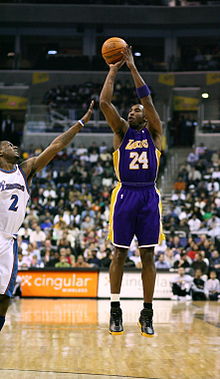Jump shot (basketball)
The jump shot ( English shot jump ) is a throwing technique in the sport of basketball .

The jump shot is a one-handed throw from a straight upward jump movement. He's the usual way of throwing from a distance today. In a one-handed jump shot, only one hand (or an arm) performs the actual throwing movement, while the other hand only supports the ball from the right or left (depending on whether you are left or right-handed) until the time of the throw and fixes it on the throwing hand .
Since the ball is thrown from overhead and from an elevated position by jumping, it is far more difficult for a defender to block than a standing throw . Another advantage is the momentum gained from the jump. Because of the swing, the player has to use less force to throw the ball, so he can throw the ball more accurately.
history
Since the invention of basketball, the two-handed standing throw together with the lay-up has dominated the game. Unlike a jump shot, the ball is thrown from a standing position. As a result, the players lacked the advantages of a modern jump shot (mentioned above).
But the jump shot developed slowly as early as the 1930s. For the first time, Hank Luisetti began to throw one hand out of the barrel instead of the usual two hands. Luisetti was extremely successful with this technique and therefore had numerous imitators. It was probably a player named Kenny Sailors who developed the one-handed jump shot from Luisetti's one-handed throw from the barrel in the early 1940s. As early as 1946, the Italian Giuseppe Stefanini became the first European to master the jump shot.
The new throwing technique enabled wingers to score more effectively from a distance. Paul Arizin of the Philadelphia Warriors was one of the most successful basket hunters in the NBA in the early 1950s thanks to the jump shot .
Variations
Lay- ups and dunking , which are independent throwing techniques, are not referred to as jump casts . The most famous variations of the jump shot are:
Fadeaway Jump Shot
A variation of the jump shot is the " fadeaway jump shot ". With a fadeaway, the player does not jump straight up, as is usual with a jump shot, but instead jumps off in a backward movement and lets himself fall backwards. The fact that the player increases the distance between the ball and himself and the defending opponent by falling backwards, making this type of throw difficult to defend, but it increases the distance to the basket. Michael Jordan , Dirk Nowitzki and Kobe Bryant used this technique in their active days.
Leaning jump shot

The " leaning jump shot " (Engl., Short leaner ) is another variation of the jump shot. In contrast to the fadeaway, the thrower does not jump backwards but in a forward movement towards the basket. The thrower can “jump past” or “jump over” the defending player after a successful deception. Another advantage of the Lean is that you can throw it out of the barrel and thus take advantage of the existing momentum. The Leaner is mostly used as a close range throw (in the immediate vicinity of the basket).
Turnaround jump shot
In the " turnaround jump shot ", the player presses his own body or back against his defender ("post"). He stands with his back to the basket and makes physical contact with his opponent. Similar to the fadeaway , he now jumps away from his defender in a twisting motion and throws the ball as soon as he has turned around 180 °. This throwing technique became known through Michael Jordan .
Step-back jump shot
The “ step-back jump shot ” is started with a step forward. The distance to the defending player is reduced. Now the thrower jumps back to his previous position and throws a normal jump shot. By stepping back, the thrower creates enough space to carry out a throw.
Bank shot
Another variant is the " bank shot ". The bank shot is a jump shot in which the ball is guided into the basket with the help of the board. The ball is usually thrown from a semi-oblique direction (approx. 45 ° angle to the board). With the help of the board, a higher accuracy is made possible. Sam Jones and Tim Duncan used this technique.
literature
- John Christgau: The Origins of the Jump Shot. Univ. of Nebraska Press, Lincoln (NE) 1999, ISBN 0-8032-6394-5 .
